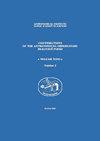The importance of studying active giant stars in eclipsing binaries -- and the role of citizen scientists in finding them
IF 0.2
4区 物理与天体物理
Q4 ASTRONOMY & ASTROPHYSICS
Contributions of the Astronomical Observatory Skalnate Pleso
Pub Date : 2020-04-01
DOI:10.31577/caosp.2020.50.2.390
引用次数: 1
Abstract
Red giant stars with deep convection zones and rapid rotation maintain a strong surface magnetic field which may alter their observable astrophysical parameters. The resulting lower surface temperature due to spots makes the inferred masses and ages from evolutionary tracks uncertain. Eclipsing binaries having an active giant component can help in finding the stellar mass independently. However, until the recent space missions it was nearly impossible to find such systems from the ground. Since the evolution on the giant branch is rapid, the number of binaries containing giant stars is low. The eclipses, if the inclination allows, are very shallow, on the order of the photometric accuracy from the ground, due to the large brightness difference between a red giant primary and its solar size or smaller secondary. And, the typically acquired data from the ground are not uniform or continuous. In this paper, a few new eclipsing binaries are presented with active giant components observed by TESS and discovered by citizen scientists, which are worthy of further studies.研究食双星中活跃巨星的重要性,以及公民科学家在寻找它们方面的作用
具有深对流带和快速旋转的红巨星保持强大的表面磁场,这可能会改变其可观测的天体物理参数。由于黑子的存在而导致的较低的表面温度使得从进化轨迹推断出的质量和年龄变得不确定。有活跃的巨星组成的食双星可以帮助独立地找到恒星的质量。然而,在最近的太空任务之前,从地面上几乎不可能找到这样的系统。由于巨星分支的演化非常迅速,包含巨星的双星数量很少。如果倾角允许,由于红巨星主星与其太阳大小或较小的次级星之间的亮度差异很大,所以日食非常浅,与地面的光度精度相当。而且,通常从地面获得的数据不是均匀的或连续的。本文介绍了由TESS观测到的、由公民科学家发现的几个新的具有活跃巨成分的食双星,值得进一步研究。
本文章由计算机程序翻译,如有差异,请以英文原文为准。
求助全文
约1分钟内获得全文
求助全文
来源期刊
CiteScore
1.10
自引率
20.00%
发文量
4
审稿时长
>12 weeks
期刊介绍:
Contributions of the Astronomical Observatory Skalnate Pleso" (CAOSP) is published by the Astronomical Institute of the Slovak Academy of Sciences (SAS). The journal publishes new results of astronomical and astrophysical research, preferentially covering the fields of Interplanetary Matter, Stellar Astrophysics and Solar Physics. We publish regular papers, expert comments and review contributions.

 求助内容:
求助内容: 应助结果提醒方式:
应助结果提醒方式:


